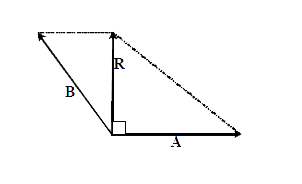The magnitudes of two vectors →P and →Q differ by 1. The magnitude of their resultant makes an angle of tan−1(3/4) with P. The angle between P and Q is
45∘
0∘
180∘
90∘
The correct Answer is:D
To solve the problem, we will follow these steps:
Step 1: Define the Magnitudes of the Vectors
Let the magnitudes of the vectors →P and →Q be p and q, respectively. According to the problem, we know that:
|p−q|=1
This means that either p=q+1 or q=p+1.
Step 2: Use the Angle Information
We are given that the angle θ between the resultant vector and vector →P is:
θ=tan−1(34)
From the definition of tangent, we can express this as:
tanθ=|→Q||→P|=qp
Thus, we have:
qp=34
This implies:
4q=3porq=34p
Step 3: Substitute and Solve for Magnitudes
Now, we can substitute q=34p into the equation |p−q|=1:
p−34p=1
This simplifies to:
14p=1⟹p=4
Now substituting back to find q:
q=34×4=3
Step 4: Calculate the Magnitude of the Resultant
Now we can find the magnitude of the resultant R using the formula:
R=√p2+q2+2pqcosα
Since we need to find α, we first calculate R:
R=√42+32=√16+9=√25=5
Step 5: Use the Resultant Magnitude to Find the Angle
Using the vector addition law:
R2=p2+q2+2pqcosα
Substituting the known values:
52=42+32+2⋅4⋅3cosα
This becomes:
25=16+9+24cosα
Simplifying gives:
25=25+24cosα
Thus:
24cosα=0⟹cosα=0
This means:
α=90∘
Conclusion
The angle between vectors →P and →Q is 90∘.
Let the magnitudes of the vectors →P and →Q be p and q, respectively. According to the problem, we know that:
|p−q|=1
This means that either p=q+1 or q=p+1.
We are given that the angle θ between the resultant vector and vector →P is:
θ=tan−1(34)
From the definition of tangent, we can express this as:
tanθ=|→Q||→P|=qp
Thus, we have:
qp=34
This implies:
4q=3porq=34p
Now, we can substitute q=34p into the equation |p−q|=1:
p−34p=1
This simplifies to:
14p=1⟹p=4
Now substituting back to find q:
q=34×4=3
Now we can find the magnitude of the resultant R using the formula:
R=√p2+q2+2pqcosα
Since we need to find α, we first calculate R:
R=√42+32=√16+9=√25=5
Using the vector addition law:
R2=p2+q2+2pqcosα
Substituting the known values:
52=42+32+2⋅4⋅3cosα
This becomes:
25=16+9+24cosα
Simplifying gives:
25=25+24cosα
Thus:
24cosα=0⟹cosα=0
This means:
α=90∘
The angle between vectors →P and →Q is 90∘.
Similar Questions
If the magnitude of two vectors are 4 and 6 and the magnitude of their scalar product is 12√2 what is the angle between the vectors?
View SolutionTwo vectors, both equal in magnitude, have their resultant equal in magnitude of the either. Find the angle between the two vectors.
View SolutionIf the magnitudes of two vectors are 3 and 4 and magnitude of their scalar product is 6 what is the angle between the vectors ?
View SolutionThe magnitude of the sum of two vectors is equal to the difference in their magnitudes. What is the angle between vectors?
View SolutionTwo forces, each of magnitude F have a resultant of the same magnitude F. The angle between the two forces is
View SolutionTwo forces, each of magnitude F have a resultant of the same magnitude F. The angle between the two forces is
View SolutionMagnitude of resultant of two vectors →P and →Q is equal to magnitude of →P . Find the angle between →Q and resultant of →2P and →Q .
View SolutionThe resultant of two vectors A and B is perpendicular to the vector A and its magnitude is equal to half the magnitude of vector B. The angle between A and B is -

View SolutionIf the magnitudes of two vectors are 2 and 3 and magnitude of their scalar product is 2√3 what is the angle between the vectors ?
View SolutionThe angle between two vector A and B is θ. Vector R is the resultant of the two vectors. If R makes an angle θ2 with A, then
View Solution
